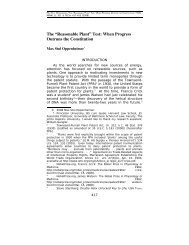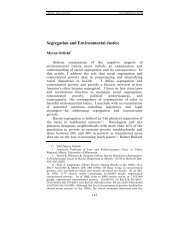An Organizational Approach to the Design of Patent Law
An Organizational Approach to the Design of Patent Law
An Organizational Approach to the Design of Patent Law
Create successful ePaper yourself
Turn your PDF publications into a flip-book with our unique Google optimized e-Paper software.
6 VERTINSKY FINAL_JAD (DO NOT DELETE) 2/27/2012 2:20 PM<br />
272 MINN. J. L. SCI. & TECH. [Vol. 13:1<br />
role in driving innovation, <strong>the</strong>n how patents influence entrepreneurial<br />
activities, <strong>the</strong> performance <strong>of</strong> start-up ventures, and<br />
<strong>the</strong> structure and nature <strong>of</strong> entrepreneurial markets should be<br />
an area <strong>of</strong> focus for patent policy-makers. 257 The Berkeley <strong>Patent</strong><br />
Survey is one <strong>of</strong> <strong>the</strong> few attempts <strong>to</strong> uncover <strong>the</strong> broader<br />
relationships between patents and entrepreneurship, exploring<br />
patenting behavior <strong>of</strong> a large selection <strong>of</strong> high technology entrepreneurs.<br />
The results suggest that <strong>the</strong> patterns and drivers<br />
<strong>of</strong> patent-holding are industry and context-specific, with venture<br />
capital financing as an important variable in differentiating<br />
behavior. 258 Evidence supports <strong>the</strong> assertion that patents<br />
are used for strategic reasons such as improving bargaining positions<br />
in cross-licensing, as well as signaling reasons such as<br />
securing early stage investment. 259 The cost <strong>of</strong> obtaining and<br />
enforcing patent rights appears <strong>to</strong> be a significant variable.<br />
Overall, <strong>the</strong> results suggest <strong>the</strong> importance <strong>of</strong> context in determining<br />
use. 260 The organizational approach provides a way<br />
<strong>of</strong> integrating <strong>the</strong> context and connecting empirical findings<br />
such as <strong>the</strong>se <strong>to</strong> determine how <strong>to</strong> encourage entrepreneurship<br />
through patent law change.<br />
By starting with <strong>the</strong> human arrangements that drive alternative<br />
processes <strong>of</strong> innovation, <strong>the</strong> organizational approach<br />
acknowledges <strong>the</strong> importance <strong>of</strong> human agency in <strong>the</strong> process<br />
<strong>of</strong> innovation. It allows for distinctions between different types<br />
<strong>of</strong> economic behavior at <strong>the</strong> level <strong>of</strong> <strong>the</strong> individual, <strong>the</strong> organization,<br />
and <strong>the</strong> market. Where <strong>the</strong>re are ac<strong>to</strong>rs that seem <strong>to</strong><br />
play a particularly important role in driving innovation, <strong>the</strong><br />
characteristics <strong>of</strong> <strong>the</strong>se ac<strong>to</strong>rs and fac<strong>to</strong>rs that facilitate or impede<br />
<strong>the</strong>ir actions become an important area <strong>of</strong> policy focus. Fo-<br />
tent?, 23 BERKELEY TECH. L.J. 1063, 1070 (2008); Ted M. Sichelman & Stuart<br />
J.H. Graham, <strong>Patent</strong>ing by Entrepreneurs: <strong>An</strong> Empirical Study, 17 MICH.<br />
TELECOMM. & TECH. L. REV. 111, 113 (2010).<br />
257. For <strong>the</strong> importance <strong>of</strong> entrepreneurs as agents <strong>of</strong> change, see Douglass<br />
C. North, The Contribution <strong>of</strong> <strong>the</strong> New Institutional Economics <strong>to</strong> an Understanding<br />
<strong>of</strong> <strong>the</strong> Transition Problems, in WIDER ANNUAL LECTURES 1, 7 (Mar.<br />
1997), available at http://www.wider.unu.edu/publications/annuallectures/en_GB/AL1.<br />
258. See Stuart J.H. Graham, Robert P. Merges, Pamela Samuelson & Ted<br />
M. Sichelman, High Technology Entrepreneurs and <strong>the</strong> <strong>Patent</strong> System: Results<br />
<strong>of</strong> <strong>the</strong> 2008 Berkeley <strong>Patent</strong> Survey, 24 BERKELEY TECH. L.J. 1255, 1326–27<br />
(2009).<br />
259. See Sichelman & Graham, supra note 256, at 112–13 (presenting evidence<br />
as <strong>to</strong> why innova<strong>to</strong>rs patent <strong>the</strong>ir new technologies).<br />
260. Id.






